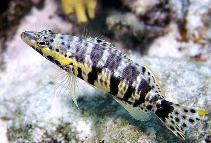http://www.fishbase.org/Summary/speciesSummary.php?genusname=Serranus&speciesname=tigrinus ---> http://192.134.151.83/Summary/speciesSummary.php?genusname=Serranus&speciesname=tigrinus
http://192.134.151.83/Summary/speciesSummary.php?genusname=Serranus&speciesname=tigrinus ---> https://fishbase.mnhn.fr/Summary/speciesSummary.php?genusname=Serranus&speciesname=tigrinus
https://fishbase.mnhn.fr/Summary/speciesSummary.php?genusname=Serranus&speciesname=tigrinus ---> https://fishbase.mnhn.fr/summary/Serranus-tigrinus.html
Serranus tigrinus, Harlequin bass : aquarium

You can
sponsor
this page
Common name (e.g. trout)
Genus + Species (e.g. Gadus morhua)
-

-
About this page
-
Languages
-
User feedbacks
-
Citation
-
Uploads
-
Related species
-


 Harlequin bass
Add your observation in
Fish Watcher
Upload your
photos
and
videos
Harlequin bass
Add your observation in
Fish Watcher
Upload your
photos
and
videos
Pictures
|
Videos |
Sounds
|
Google image
 Serranus tigrinus
Serranus tigrinus
Picture by
Patzner, R.
Teleostei (teleosts) >
Perciformes/Serranoidei
(Groupers) >
Serranidae
(Sea basses: groupers and fairy basslets)
Etymology:
Serranus:
Latin, serran, serranus, saw and a fish of genus Serranus (Ref.
45335
)
.
More on author:
Bloch
.
Environment: milieu / climate zone / depth range / distribution range
Ecology
Marine; reef-associated; depth range 0 - 40 m (Ref.
9710
). Tropical; 33°N - 7°N, 96°W - 58°W
Western Atlantic: Bermuda and southern Florida, USA to northern South America; throughout the Caribbean (Ref.
13442
). Including Antilles (Ref.
26938
).
Size / Weight / Age
Maturity: L
m
?
range ? - ? cm
Max length : 29.0 cm FL male/unsexed; (Ref.
6937
)
Dorsal
spines
(total): 10;
Dorsal
soft rays
(total): 12. Snout long and pointed. Black stripes and bars forming irregular rectangles on body. Has unique pointed snout and distinct color pattern make it easy to identify (Ref.
26938
).
Most common in areas with rock or scattered coral. Solitary or in pairs. Feeds mainly upon crustaceans (Ref.
5521
). Synchronously hermaphroditic. The most common member of the genus (Ref.
9710
).
Life cycle and mating behavior
Maturity
|
Reproduction
|
Spawning
|
Eggs
|
Fecundity
|
Larvae
Displays facultative monogamy where males are constrained to mate with a single female due to resource limitation (Ref.
52884
). Pelagic spawner (Ref.
32216
).
Robins, C.R. and G.C. Ray
, 1986. A field guide to Atlantic coast fishes of North America. Houghton Mifflin Company, Boston, U.S.A. 354 p. (Ref.
7251
)
IUCN Red List Status (Ref.
130435
)
Least Concern (LC)
; Date assessed:
04 February 2009
CITES
Not Evaluated
Not Evaluated
Threat to humans
Harmless
Human uses
Aquarium: commercial
FAO - Publication:
search
|
FishSource
|
More information
Countries
FAO areas
Ecosystems
Occurrences
Introductions
Stocks
Ecology
Diet
Food items
Food consumption
Ration
Common names
Synonyms
Metabolism
Predators
Ecotoxicology
Reproduction
Maturity
Spawning
Spawning aggregation
Fecundity
Eggs
Egg development
Age/Size
Growth
Length-weight
Length-length
Length-frequencies
Morphometrics
Morphology
Larvae
Larval dynamics
Recruitment
Abundance
BRUVS
References
Aquaculture
Aquaculture profile
Strains
Genetics
Electrophoreses
Heritability
Diseases
Processing
Nutrients
Mass conversion
Collaborators
Pictures
Stamps, Coins Misc.
Sounds
Ciguatera
Speed
Swim. type
Gill area
Otoliths
Brains
Vision
Tools
Bio-Quiz
|
E-book
|
Field guide
|
Identification keys
|
Length-frequency wizard
|
Life-history tool
|
Point map
|
Classification Tree
|
Catch-MSY
|
Special reports
Check for Aquarium maintenance
|
Check for Species Fact Sheets
|
Check for Aquaculture Fact Sheets
Download XML
Summary page
|
Point data
|
Common names
|
Photos
Internet sources
AFORO (otoliths) |
Aquatic Commons
|
BHL
|
Cloffa
|
BOLDSystems
|
Websites from users
|
Check FishWatcher
|
CISTI
|
Catalog of Fishes
:
genus
,
species
|
DiscoverLife
|
DORIS
|
ECOTOX
| FAO - Publication:
search
|
Faunafri
| Fishipedia |
Fishtrace
| GenBank:
genome
,
nucleotide
|
GloBI
|
Google Books
|
Google Scholar
|
Google
| IGFA World Record |
MitoFish
|
National databases
|
Otolith Atlas of Taiwan Fishes
|
Public aquariums
|
PubMed
|
Reef Life Survey
| Socotra Atlas |
Tree of Life
| Wikipedia:
Go
,
Search
| World Records Freshwater Fishing |
Zoological Record
Estimates based on models
Preferred temperature (Ref.
123201
): 25.3 - 28.1, mean 27.1 °C (based on 138 cells).
Phylogenetic diversity index (Ref.
82804
): PD
50
= 0.5000 [Uniqueness, from 0.5 = low to 2.0 = high].
Bayesian length-weight: a=0.01023 (0.00614 - 0.01704), b=3.04 (2.90 - 3.18), in cm total length, based on LWR estimates for this species & Genus-body shape (Ref.
93245
).
Trophic level (Ref.
69278
): 3.5 ±0.37 se; based on food items.
Resilience (Ref.
120179
): Medium, minimum population doubling time 1.4 - 4.4 years (Preliminary K or Fecundity.).
Fishing Vulnerability (Ref.
59153
): Low vulnerability (22 of 100).
Nutrients (Ref.
124155
): Calcium = 50.5 [31.2, 89.5] mg/100g; Iron = 0.572 [0.316, 0.948] mg/100g; Protein = 18.4 [16.6, 20.0] %; Omega3 = 0.148 [0.100, 0.221] g/100g; Selenium = 28.3 [18.0, 49.0] μg/100g; VitaminA = 112 [41, 346] μg/100g; Zinc = 1.29 [0.90, 1.80] mg/100g (wet weight);
Back to Search
Random Species
Back to Top
Accessed through:
Not available
FishBase mirror site :
localhost
Page last modified by :
mrius-barile
- 20 July 2016
Fatal error
: Uncaught ArgumentCountError: Too few arguments to function checkEcotox(), 1 passed in /var/www/html/summary/speciessummary.php on line 2304 and exactly 3 expected in /var/www/html/includes/speciessummary.lib.php:2579 Stack trace: #0 /var/www/html/summary/speciessummary.php(2304): checkEcotox() #1 {main} thrown in
/var/www/html/includes/speciessummary.lib.php
on line
2579
|